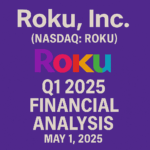AEye, Inc. (NASDAQ: LIDR)
Q2 2025 Financial Analysis | July 31, 2025
Executive Summary
AEye reported a transformational second quarter 2025, marking a critical inflection point as the company moved beyond the development phase to deliver sustained growth. While revenue remained minimal at $22,000, the company achieved significant commercial milestones including tripling new business wins from 2 to 6 contracts and securing a potential $30 million revenue opportunity with a leading transportation OEM. The company’s sales funnel has grown exponentially with active engagement across more than 100 potential customers, positioning AEye for substantial growth acceleration.
Q2 2025 Highlights
Financial Performance
AEye’s Q2 2025 financial results reflect the company’s current position as a pre-revenue growth stage technology company. While quarterly revenue decreased to $22,000 from $32,000 in Q2 2024, the six-month revenue increased significantly to $86,000 from $52,000 in the prior year period, indicating improving momentum in the first half of 2025.
The company reported a GAAP net loss of $9.3 million, or $0.48 per share, in Q2 2025 compared to $8.0 million, or $1.16 per share, in Q2 2024. The improvement in per-share metrics reflects the significant increase in weighted average shares outstanding from 6.9 million to 19.1 million due to capital raising activities. On a non-GAAP basis, excluding stock-based compensation and other adjustments, the net loss was $6.7 million, or $0.35 per share.
Cash burn excluding net financing proceeds was $7.1 million in Q2 2025, demonstrating the company’s disciplined approach to expense management while investing in growth initiatives. For the six-month period, operating cash flow was negative $14.2 million, which is improved from negative $14.2 million in the prior year despite increased business development activities.
The company’s gross loss was $86,000 in Q2 2025 compared to $128,000 in Q2 2024, primarily due to lower cost of revenue. Operating expenses totaled $8.6 million, with research and development representing the largest component at $3.7 million, reflecting the company’s continued investment in product development and technology advancement.
Significant financing activities in the first half of 2025 included raising $10.1 million through common stock purchase agreements and $2.2 million net proceeds from convertible note issuances, strengthening the company’s balance sheet to support growth initiatives and commercial expansion.
Business Development & Commercial Progress
AEye achieved remarkable commercial progress in Q2 2025, demonstrating the significant market traction for its advanced lidar technology solutions:
Major Business Wins
- Transportation OEM Partnership: Selected by a leading global transportation OEM for a potential $30 million revenue opportunity, which is expected to begin contributing to revenue in 2025
- Contract Growth: Tripled new business wins from 2 to 6 contracts across diverse market verticals in 2025
- Pipeline Expansion: Sales funnel has grown exponentially with active engagement across more than 100 potential customers
- Non-Automotive Opportunities: Visibility to additional non-automotive orders potentially totaling thousands of units
Strategic Platform Integrations
Apollo lidar sensor achieved critical strategic milestones:
- Full integration into NVIDIA DRIVE AGX Orin platform, driving expanded engagement opportunities with leading OEMs and paving the way for Hyperion integration
- Selection for the GM-sponsored WinTOR initiative, creating potential for significant sourcing advantage for future OEM programs
- OPTIS™ platform launch powered by NVIDIA Jetson Orin, with secured deployments in airport safety and security, perimeter monitoring, and transportation logistics
Market Diversification
The company has successfully expanded beyond automotive applications:
- Airport Safety & Security: Multiple OPTIS™ deployments secured
- Perimeter Monitoring: Active contracts in security applications
- Transportation Logistics: Growing engagement in logistics and supply chain applications
- Intelligent Transportation Systems: Expanding into smart infrastructure markets
CEO Matt Fisch noted: “Our sales funnel has grown exponentially – we’re actively engaged with more than 100 potential customers and have signed six new contracts across a range of market verticals in 2025.” This represents a fundamental shift from development-focused activities to commercial execution and revenue generation.
Technology Platform & Product Development
AEye’s technology platform continues to demonstrate industry-leading capabilities, with significant advancements in both hardware and software solutions:
Apollo Lidar Sensor
- Long-Range Performance: Capability to detect objects at up to one kilometer, providing superior range compared to competitors
- Small Form Factor: Compact design enabling easier integration into various vehicle and infrastructure applications
- Software-Defined Architecture: Enables advanced driver-assistance, vehicle autonomy, and smart infrastructure applications
- NVIDIA Integration: Full compatibility with NVIDIA DRIVE AGX Orin platform enhances market accessibility
OPTIS™ Full-Stack Solution
The newly launched OPTIS™ platform represents AEye’s evolution into complete system solutions:
- Powered by NVIDIA Jetson Orin for enhanced processing capabilities
- Captures high-resolution 3D images of the environment
- Real-time interpretation and decision-making capabilities
- Provides actionable direction based on environmental analysis
- Secured multiple deployments across diverse applications
Research & Development Investment
R&D expenses totaled $3.7 million in Q2 2025, representing the largest component of operating expenses and demonstrating continued commitment to innovation. The six-month R&D investment of $7.2 million, while down from $8.4 million in the prior year, reflects more focused and efficient development activities.
The company’s technology roadmap focuses on expanding applications beyond traditional automotive use cases into high-value markets including defense, security, and intelligent infrastructure, positioning AEye to capitalize on the broader lidar market opportunity.
Balance Sheet & Liquidity
| Balance Sheet Item | June 30, 2025 ($000) | December 31, 2024 ($000) | Change |
|---|---|---|---|
| Cash and Cash Equivalents | $2,374 | $10,266 | -77% |
| Marketable Securities | $16,836 | $12,012 | +40% |
| Total Current Assets | $20,412 | $25,171 | -19% |
| Total Assets | $22,102 | $27,120 | -19% |
| Total Current Liabilities | $10,587 | $11,307 | -6% |
| Total Stockholders’ Equity | $10,182 | $15,124 | -33% |
AEye maintains a solid balance sheet position despite the cash utilization for operations and strategic initiatives. Combined cash and marketable securities totaled $19.2 million as of June 30, 2025, providing the company with adequate liquidity to execute its growth strategy.
The company’s liquidity position reflects strategic capital management with marketable securities increasing to $16.8 million from $12.0 million at year-end 2024, while cash and cash equivalents decreased to $2.4 million from $10.3 million. This shift represents efficient cash management and investment in higher-yielding securities.
CFO Conor Tierney noted that the company has “more than tripled” its cash position since quarter-end through additional financing activities, significantly strengthening the balance sheet. The company raised capital through:
- Common stock purchase agreements generating $10.1 million in proceeds
- Convertible note issuances providing $2.2 million net proceeds
- Strategic management of working capital and operational efficiency
Total stockholders’ equity of $10.2 million provides a solid foundation for continued operations and growth investments. The company’s debt position includes $2.1 million in convertible notes, representing manageable leverage levels.
With the strengthened balance sheet and disciplined cash management approach, AEye is well-positioned to fund its commercial expansion activities while maintaining operational flexibility during the critical growth phase.
Strategic Outlook & Growth Strategy
AEye has provided guidance and strategic direction for continued growth and market expansion:
2025 Financial Outlook
- Full-year cash burn expected to be within $27-29 million range, as previously communicated
- Revenue generation expected to begin from the $30 million transportation OEM opportunity in 2025
- Additional revenue opportunities from six new business wins and expanding customer pipeline
Market Expansion Strategy
The company is executing a multi-vertical growth strategy:
- Automotive Market: Leverage NVIDIA platform integration and GM WinTOR participation for OEM engagement
- Non-Automotive Markets: Capitalize on OPTIS™ platform for airport security, perimeter monitoring, and logistics applications
- Infrastructure Solutions: Expand into intelligent transportation systems and smart city applications
- Defense & Security: Target high-value defense applications with advanced lidar capabilities
Competitive Positioning
AEye’s competitive advantages include:
- Long-range detection capability up to one kilometer
- Software-defined lidar solutions enabling customization
- Strategic partnerships with NVIDIA and access to leading OEM programs
- Full-stack solution capability through OPTIS™ platform
- Proven ability to scale across diverse market applications
Management emphasized that the company is “primed to scale rapidly and deliver long-term value across a wide range of intelligent systems applications” as demand accelerates across multiple market verticals.
Risks & Opportunities
Opportunities
Risks
Conclusion
Strengths
- Tripled new business wins demonstrating strong commercial traction
- $30 million transportation OEM opportunity providing significant revenue potential
- Strategic NVIDIA platform integration expanding market access
- Diversified market approach across automotive and non-automotive applications
- Strong technology platform with unique long-range capabilities
Areas to Monitor
- Execution on large contract opportunities and revenue conversion
- Cash burn management and funding requirements
- Market adoption timeline for autonomous vehicle technologies
- Competitive positioning in rapidly evolving lidar market
- Scaling operations to support growth opportunities
Summary
AEye achieved a critical inflection point in Q2 2025, transitioning from a development-focused company to one demonstrating substantial commercial traction. While revenue remains minimal at $22,000 quarterly, the company tripled new business wins and secured a potential $30 million revenue opportunity that is expected to begin contributing to revenue in 2025.
The company’s strategic positioning has been significantly enhanced through full integration into the NVIDIA DRIVE AGX Orin platform and selection for the GM-sponsored WinTOR initiative. The launch of the OPTIS™ platform powered by NVIDIA Jetson Orin has enabled expansion into high-value non-automotive applications, with multiple deployments already secured across airport safety, perimeter monitoring, and transportation logistics.
With active engagement across more than 100 potential customers and visibility to additional orders potentially totaling thousands of units, AEye’s sales funnel has grown exponentially. The strengthened balance sheet, supported by successful capital raising activities, provides adequate resources to execute on the company’s growth strategy.
While execution risks remain given the early stage of revenue generation, AEye’s unique technology capabilities, strategic partnerships, and diversified market approach position the company well to capitalize on the expanding lidar market opportunity across automotive, infrastructure, security, and defense applications.
Source: AEye Q2 2025 Earnings Release



